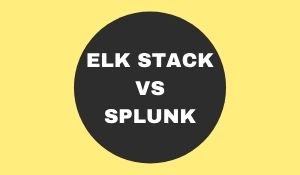
Splunk vs ELK: Which Works Best For You?
Splunk or ELK, two of the most extensively used tools in the area of Operational Data Analytics. Both Spunk and ELK share a common aim, that is, to solve Log Management issues and make it more seamless. Log Management solutions such as Spunk and ELK are essential to an organization’s layered security framework. Without them, companies would hardly ever have any visibility into the actions and events taking place inside their infrastructures that could be a source of vulnerability.
Splunk and ELK are two of the main company solutions in this category, Splunk takes a pile of data and permits people to search via the data to extract what they need. ELK requires greater work and planning, in the beginning, however, the value extraction is simpler at the end. Most, if not all, systems and devices in today’s IT environments generate large log files that document the minutiae of day-to-day operations: what resources have been accessed and by whom, activities performed, errors/exceptions encountered through the host, and more. Log management and analysis solutions allow companies to glean collective, actionable intelligence from this sea of data.

In the face of the ever-growing log data of IT companies, Spunk and ELK are seeking to manage the expanding log data while providing a scalable strategy to collect and index log files and provide a search interface to engage with data. Both Splunk and the ELK Stack can be used to monitor and analyze infrastructure in IT operations as well as for application monitoring, security, and business intelligence. In this article, the gist of the difference between Splunk and ELK and see how they compare to each other in various aspects.
About ELK?
ELK is an open-source, consolidated data analytics platform. ELK’s software stack comprises Elasticsearch, a distributed RESTful search/analytics engine, Logstash, a data processing pipeline, and Kibana for data visualization. Only lately did Beats be a part of the stack.
What is Splunk?
Splunk is so popular in the industry that it has come to be recognized as the “Google for log files.” Splunk is one of the top DevOps tools in the market. Apart from being a log management and analysis solution, Splunk is additionally a Security Information and Event Management (SIEM) solution. With Splunk, users can unify log file data accumulated from various systems and devices across an IT environment and function higher-order security analyses and assessments to determine the collective state of the company’s systems from a unified interface. Splunk makes use of a proprietary search language – Search Processing Language (SPL) – for serving and executing contextual queries large data sets. It additionally boasts of over one thousand apps and add-ons designed to extend its capabilities to accommodate disparate data sources.
Key Difference between Splunk and ELK
| Parameters | Splunk | Elastic Search |
|---|---|---|
| Basics | The biggest problem with Splunk was and still is that it is an expensive and paid tool | ElasticSearch is a free and open-source solution. |
| Target Problem and Solution | Splunk has traditionally served the large organization clients in the past which are opting out for an on-premises solution because of the data integrity issues and now they are trying to capture the smaller companies as their client through making their services affordable. | Elastic Search, on the other hand, tends to provide end to end open source and some premium services for all kinds of companies out there in this domain. |
| Set-Ups | Splunk has distributed their services around two modules Splunk Enterprise pursuits the on-prem specializations and Splunk Cloud tries to serve the cloud-based specializations via the web app as both have comparatively similar features. The everyday limits of usage are the things which are on the table for bargains with both the services. | ElasticSearch has only one SaaS platform which has a paid module for deployment, rest other modules are a free and open source which are simply very helpful for small companies to monitor their organisation logs without paying any money for their personal data. |
| API and Extensibility | Splunk has a well-documented RESTful API that contains more than 200 endpoints for accessing various features in Splunk, including SDKs in the most popular languages. | Elasticsearch is a distributed search and analytics engine that leverages the standard RESTful API and JSON. |
| The UI and Dashboards Visualizations |
Eventually, Splunk has multiplied their user interface with new dashboard controls, good and interacting graphical interfaces and abilities to assign the tasks and workflows to the team members with respect to their departments. They have obtained a feature of exporting their dashboards to PDF. |
Elastic search comes with no UI of its own but the tasks can be inherited to Kibana and it has really very cool background themes which aren’t there in Splunk. So the dashboard personalization is kind of better in Kibana. |
| Data Migration and User Management |
As Splunk comes with inbuilt and pre-configured features which allows it to map the data into entities with respective values. |
ElasticSearch comes with no such pre-loaded wizards and features which are very easy and reliable for use. |

To conclude, both Splunk and ELK/Elastic Stack are competent, enterprise-grade log management and analysis systems trusted through the world’s main organizations. Each has its unique benefits and limitations, and hence, the advantages of these two tools generally rely on user-specific needs and requirements. For any small or medium organization having a low price range need to go for ELK while a large corporation has to choose Splunk over ELK.

